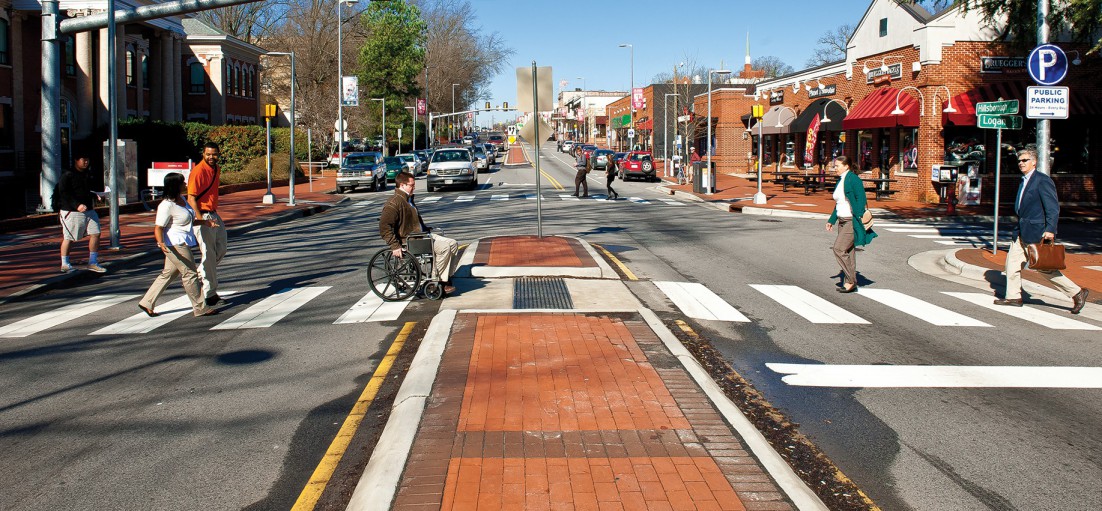Action Steps
Safety
Improve safety for all roadway users through strategic, consistent, and connected pedestrian and bicycle facility improvement, education, and enforcement strategies.
| ID | Recommended Action Step Idea | Lead Agency | Agency Partner(s) | Chapter Ref. |
|---|---|---|---|---|
| Sa1 | Implement "Complete Streets" approach consistently with all roadway projects to ensure connected, accessible, and safe pedestrian and bicycle network. | NCDOT | 3,4 | |
| Sa2 | Develop strategy to advertise and educate NCDOT Division staff, MPOs/RPOs, cities, counties, advocates, and law enforcement staff across the state about HSRC crash analysis and data and trends in North Carolina. | NCDOT | HSRC, ITRE | 3,4 |
| Sa3 | Work with law enforcement and other agencies to improve the quality and completeness of pedestrian and bicycle crash data. | NCDOT | Law enforcement, Hospitals, HSRC, MPOs/RPOs, local governments | 3,4 |
| Sa4 | Consider establishing statewide pedestrian and bicycle safety consortium to develop consistent, thorough recording of crashes. | NCDOT | Law enforcement, Hospitals, HSRC, MPOs/RPOs, local governments, BikeWalkNC | 3,4 |
| Sa5 | Evaluate facilities and programs for their capability to improve motorist/pedestrian/bicyclist compliance and safety. Utilize national studies and FHWA crash reduction factors shown in following table to support design solutions for safety improvement (see Chapter 6 – Pedestrian & Bicycle Toolbox). | NCDOT | 3,4 | |
| Sa6 | Evaluate the existing HSIP prioritization and project programming process and adjust as needed to allow for more bicycle and pedestrian project success. | NCDOT | HSRC | 3,4 |
| Sa7 | Develop an injury minimization approach for setting speed limits on new roadways and major roadway reconstruction projects. | NCDOT | 3,4 | |
| Sa8 | Adopt high-priority performance measures described in Chapter 8. | NCDOT | 9.11 | |
| Sa9 | Maintain the Safety & Mobility safety audit team to review roadway improvement plans in high crash locations. Encourage additional study. | NCDOT DBPT, Traffic Safety Unit | 3,4 | |
| Sa10 | Implement education, encouragement, and enforcement programs as detailed in Chapter 7. | NCDOT | BikeWalkNC, advocacy groups, MPOs/RPOs, municipalities | |
| Sa11 | Remain current with research regarding bicycle safety as bicycle planning and design is evolving rapidly in the United States. | NCDOT | HSRC | 4 |
| Sa12 | Address safety needs of different types/experience levels of bicyclists. | NCDOT | 4 | |
| Sa13 | Consider continuing successful pedestrian/bicycle safety reviews conducted by the Traffic Safety Unit (examples: Fayetteville and the Outer Banks (US 158) in areas of safety concern. | NCDOT DBPT, Traffic Safety Unit | 3,4 | |
| Sa14 | Engage more stakeholders in a comprehensive approach to improving safety for pedestrians. | NCDOT | ITRE, HEC, law enforcement, hospitals, MPOs/RPOs, local governments | 3,4 |
| Sa15 | Maintain the NCDOT Traffic Safety Unit approach to review high crash locations. This team should be proactive using pedestrian/bicycle crash data regularly. | NCDOT | 3 | |
| Sa16 | Incorporate ongoing HSRC crash typing and geocoding efforts into decision-making and prioritization. | NCDOT | 3 | |
| Sa17 | Conduct studies at high pedestrian and bicycle crash locations and coordinate results with the HSIP process to provide pedestrian countermeasures in these locations. The agency should explore the development of a model to estimate pedestrian and bicyclist volumes, with the purpose of developing better prioritization methods that account for crash rates in addition to crash frequency. If possible, the model should be compatible and/or coordinated with analytical models currently used by other state agencies. | NCDOT | 3 | |
| Safety: Safe Routes to School | ||||
| Sa18 | Continue the Safe Routes to School program as part of DBPT following the full obligation of SAFETEA-LU funding. | NCDOT-DBPT | 3 | |
| Sa19 | Continue new public health collaboration with DHHS/Community Transformation Grant in order to reach more communities and schools around the state. | NCDOT-DBPT | DHHS | 3 |
| Sa20 | Explore ways to simplify and streamline SRTS grant and implementation processes. | NCDOT-DBPT | 3 | |





